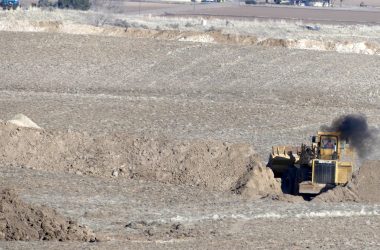NYSSA – The contract with the engineering firm that directed work on the Treasure Valley Reload Center for more than six years was terminated earlier this month as officials appear to be moving in a new direction with the project.
Shawna Peterson, the executive director of the Malheur County Development Corp., notified Anderson Perry & Associates Inc. in a letter Dec. 8 its contract was terminated. The letter was addressed to Brad Baird, the lead engineer on the project.
Peterson said she ended the years-long contract because the services of the firm had become “redundant.”
She said that since she was hired as executive director in February, she gradually assumed the role of leading the board meetings and dealing with contractors and stakeholders, tasks previously handled by the engineering firm.
The decision was the “fiscally responsible thing to do,” said Peterson.
Peterson noted that construction on the rail project has stopped.
During the past six months key players in the publicly-funded, multimillion-dollar project have either walked away or ceased work.
Greg Smith, former Malheur County economic development director, quit as project manager in February after about five years in the role. In July, Americold, set to operate the facility, pulled out after determining the Nyssa rail center was not “financialy viable.”
Meantime, the development company let expire its contract with RailPros, which handled engineering of the rail system in Nyssa.
In August, state officials put the brakes on the flow of money to the facility and urged project developers to find a new operator and find money to finish the venture.
As a result, all work on the reload center has stopped. Rail spurs are unfinished, the main warehouse building sits on the ground in pieces, and project officials estimate they need another $10 million to finish the project as envisioned.
Peterson is leading an effort to evaluate a new future for the project. The Oregon Department of Transportation is giving her until February to submit a new plan. Then, the agency will decide whether to halt the state investment and drop out of the project. Grant Kitamura, an onion industry executive and president of the development corporation, said engineering work was not needed for now.
“There isn’t much to be done. There is no ill will. No one is mad at anyone. They understood we can’t keep paying them when they are not doing anything,” said Kitamura.
Baird and Chas Hutchins, president of Anderson Perry & Associates, didn’t respond to requests for comment. Hutchins replaced Baird as president of the company in April.
The firm has been paid $1.9 million for its work. Peterson said she is reviewing a recent invoice for another $24,136.
The termination of the engineering contract is yet another major shift in the storyline of the reload center. The La Grande firm sat at the epicenter of the project from its infancy but stumbled at key points. Those miscues triggered delays in construction and helped the project budget to swell.
Anderson Perry has been involved in the project from the start, doing early design work in 2017 after the Oregon Legislature set aside $26 million for the reload center.
In early 2021, Baird privately raised the alarm that the $26 million wouldn’t be enough. Baird gave Smith a handwritten note calculating the project was at least $3.6 million short to build the reload center. But Smith submitted paperwork to the state claiming the project would be built and running for the original budget. Baird at the time didn’t answer questions about the matter. He has never publicly explained his warning or why he didn’t share with state officials or the development company board.
Instead, the project team pushed ahead to launch construction despite Baird’s warning.
Problems mounted quickly.
In 2021, regulators at the state Department of Environmental Quality and the U.S. Corps of Engineers rejected permits sought by Anderson Perry because applications were incomplete, adding months of delay. Baird told development company officials at the time that such problems were typical.
When construction finally launched later that year, contractors quickly discovered a far worse site than anticipated. They had to fill in a wetland that Anderson Perry never fully investigated, finding a much deeper hole than expected.
“No explorations occurred in the wetland area, which is the area where the most significant impact for additional rip rap materials occurred,” Baird would later report to the board.
As a result, contractors spent millions beyond what was budgeted to fill in the wetland and other soft spots on the Nyssa site. The amount of rock trucked in to fill the wet areas increased significantly, from 40,000 tons to 156,000 tons. Project engineers also originally called for 29,500 tons of a certain class of rip rap to be used for the rail lines, but that total jumped to 92,700 tons.
As costs mounted, Smith told the development company board in April 2022 that he was shelving construction of one of four rail spurs to the site. Baird assured board members at the time that the Nyssa operation could run without the spur even though an earlier operating plan showed it was a vital piece for shipping operations.
Six months later, the development corporation learned Union Pacific required the rail spur or it wouldn’t serve the facility. At the time Baird voiced surprise, calling the development a “gut punch.”
The development company could produce no records at the time that Anderson Perry had consulted with Union Pacific about the plan to drop the rail spur. Engineering plans from Anderson Perry noted that any change would require the railroad’s approval.
Adding back the rail spur loaded $3.2 million in unexpected costs on the project.
The problems for Anderson Perry continued into 2023.
An effort to get a building permit to raise the warehouse building faltered. Malheur County officials rejected the application because of errors and missing information.
A contractor was nonetheless launched on the warehouse building, starting foundation work that didn’t need a permit. But as the fate of the reload center became more uncertain, the work was halted and the building contract eventually terminated.
In September, what appeared to be a major stumbling block appeared when Baird reported that Union Pacific questioned the materials used to build the more than three miles of track at the site.
Baird assured the development corporation that Union Pacific inspected and approved what had been built. He also repeated that assertion in an interview with the Enterprise.
An investigation by the Enterprise, though, found that important construction steps were not executed while Anderson Perry engineers appeared unclear who was doing what regarding the construction of the rail lines. At the time, the development corporation faced the specter of rebuilding all the track because the change in materials was not approved by Union Pacific before construction began.
Anderson Perry in October won the railroad’s approval of the changed design after submitting new data.
News tip? Contact reporter Pat Caldwell at [email protected].
Previous coverage:
Malheur County says Smith cost it nearly $70,000, wants his company to pay up
State halts funding for Treasure Valley Reload Center, imposes conditions
BY THE NUMBERS: County calculates money it has put into Nyssa rail project
Permit glitches impede progress on rail reload project
Key study that justified Nyssa reload center now doubted by long-time board members




